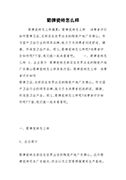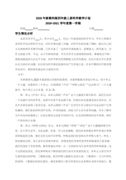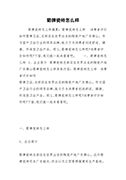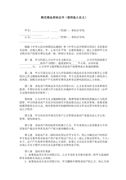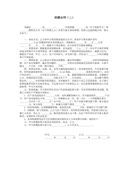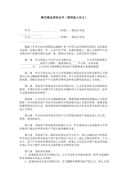《牛津小学英语》4B Unit 2 单元教材分析(精选16篇)四年级英语教案
《牛津小学英语》4B Unit 2 单元教材分析(精选16篇)
《牛津小学英语》4B Unit 2 单元教材分析 篇1
单元分析:
本单元的主要教学内容是“根据特征认人”。“认人”是在第一单元所学句who's that…?he's/she's...基础上进行的拓展学习。本单元的教学重点是让学生根据人的外貌特征及穿着打扮来认识人,从而学习掌握who's the ... with...? is that…your...? the one in the...等句型,及相关的家庭成员、身体部位、颜色、服装等类单词。前几册我们已学了部分相关类别的单词,教师可以用以旧带新的方法来教本单元的新单词,还可以结合以前所学的内容,系统整理这些单词。
教学要求:
1. 能听得懂、会说、会读和会拼写单词grandfather, grandmother, father, mother, brother, sister, white , a friend。
2. 能听得懂、会说和会读日常交际用语nice to meet you. we're late for the party. let's hurry!
3. 能听得、会说、会读和会写句who's the…? he's/she's... is that... your ...? which one? the one in the...。
4. 了解辅音字母组合ck在单词中的读音。
5. 能有表情、有节奏地朗读歌谣my brother。
教学重点及难点:
1. 能听得懂、会说、会读和会拼写单词grandfather, grandmother, father, mother, brother , sister, white, a friend。
2. 能听得懂、会说、会读和会写句型who's the…with? he's /she's … is that …your…?
which one? the one in the …。
课时安排:
本单元共安排6课时。
第一课时:part b and part c
第二课时:part d look and say
第三课时:part a read and say
第四课时:part e and part f
第五课时:part g and check
第六课时:do the workbook
友情提示:
1. 第一课时安排内容看起较多,其实对于家庭成员单词学生都已会说,在这里可由谈话引出,教师只需指导学生记忆即可。
2. 句型“who's ...with...?”“the one in the ...”学生在时对“with”及“in”易混淆,教师应多作对比,进行强化练习。
3. 备课中前一课时留下的作业在下一课时都有所体现,使用备课时教师要留意。
《牛津小学英语》4B Unit 2 单元教材分析 篇2
unit 1 who is younger?
单元教材分析:
本单元的主要话题是两种事物的比较,通过ben, jack和su hai之间的闲聊引出本单元的主要语言项目:形容词比较级。教师可创设情景,用实物或动作将比较级的概念清晰明了地传播给学生,同时注重比较级单词的读法与写法规律。
教学目标:
1.能听懂会说、会读、会写单词tall, young, old, heavy。
2、能听懂会说、会读单词和词组twin, minute, centimeter, child, also, chat。
3、能听懂会说、会读日常交际用语:i’m as tall as you. su yang’s twenty minutes younger than su hai. whose school bag is heavier, yours or mine?
4.能听懂、会说、会读、会写句型who’s taller then david? gao shan is taller than david。
5.了解字母组合or在单词中读音。
6.会唱歌曲i wish i was taller。
教学重点:
1.能掌握本单元的四会单词、句型。
2.灵活运用形容词的比较级于真实情景中。
教学难点:掌握形容词比较级的读写规律及用法。
教具准备:录音机.磁带.挂图.图片.相关的实物等。
课时安排:第一课时:b. look read and learn c. work in pairs
第二课时:a. listen, read and say
第三课时:c. work in pairs d. listen and write
第四课时:e. look, read and judge 练习册a部分
第五课时:f. play a game g. listen and repeat 练习册b部分
第六课时:h. sing a song 练习册c.d.e.f部分
友情提示:
1.注重各环节中的情景设计.本单元重点学生形容词及其比较级用法。教学中,教师在每个环节中都要注重对情景的设计。利用实物进行比较,让学生对比较级有直观清晰认识。另外本单元牵涉到人物的比较,教学中可联系学生实际进行语言交际,让学生在真实的交际中体会语言,学习语言。
2. 注重对语法知识的渗透讲解.学生刚接触比较级对其用法易模糊,特别对于“…than…”和“…as…as…”两句型易混淆,因此教学中教师有必要对学生对此句型进行简单梳理,讲清两句型特点及区别。(详细内容见教参)
3. 注意对“who’s(比较级)than…?”和“whose…is(比较级)?”两句型的区别讲解,在教学中学生对这两句型的构成易混淆,教师要注意在新授时帮助学生理清句式特点及句意。
《牛津小学英语》4B Unit 2 单元教材分析 篇3
unit 8 review and check
连云港市赣榆县青口中心小学 刘颖
单元教材分析:
本单元是6b的第二个复习单元,也是全书的最后一个单元。各部分教学内容均在前一个单元话题的基础上有所扩展,并提供了一些新的呈现方式,重点复习第五单元至第七单元所涉及的语言项目。通过看图对相关信息进行介绍,看图完成对话及短文,看图对话,同学之间谈论自己的好朋友等方式帮助学生复习巩固三个单元中所学的语音、词汇、日常交际用语、句型等基础知识。某些练习的要求较前几个单元有所提高,更多地要求学生综合以前所学语言灵活地加以运用,从而进一步提高学生综合运用语言的能力。
教学目标:
1、通过复习,要求学生掌握五至七单元的四会单词、词组和句型;
2、通过复习操练,要求学生能综合运用所学的日常交际用语。
教学重点:
通过复习,学生能掌握五至七单元的四会单词、词组和句型。
教学难点:
1、学生能正确地书写五至七单元的四会单词及句型;
2、学生能综合运用所学的日常交际用语。
教具准备:录音机、课前录音、多媒体画面、词汇卡片。
课时安排:本单元共计四课时
第一课时unit8 a look, read and say.
第二课时unit8 b look, read and write.
第三课时unit8 c look and talk
第四课时unit8 d talk and write.
友情提示:
本单元容量大,综合性强,教师在课前有必要对全书所学内容进行归纳总结,以便对全书有个清楚全面、整体的把握。在教学过程中要及时分析学生的现状,针对他们的掌握情况采取灵活有趣、高效的方法,充分利用复习课的机会查漏补缺。
《牛津小学英语》6b unit 8 单元教材分析 来自98e范文网。
《牛津小学英语》4B Unit 2 单元教材分析 篇4
unit 4 review and check
连云港市赣榆县青口中心小学 肖淑芳
单元教材分析:
本单元是复习单元,着重归纳了第一单元至第三单元的主要语言项目,通过看图编号,说说讲讲,完成句子等练习,帮助学生复习巩固以学的词汇,句型和日常交际用语,使学生的听、说、读、写能力在原有的基础上有所提高。在教学时,教师要分析学生的学习现状,课堂上根据学生的掌握情况,尽量采用图片,实物,多媒体等直观教具,结合游戏,情景对话等形式,对基础知识和基本技能进行训练,从而提高学生灵活运用语言的能力。
教学要求:
1 通过复习,使学生熟练的掌握四会单词,词组和句型。
2 通过本单元的复习操练,要求学生能综合运用所学的日常交际用语。
教学重点:
1 掌握一至三单元的四会单词,词组及句型。
2 掌握一至三单元的日常交际用语,并在实际生活中熟练运用。
教学难点:
1 能根据情景正确的使用形容词和副词的比较级。
2 能会用英语问路。
教具准备:
录音机、磁带、图片及相关实物。
课时安排 : 共四课时。
第一课时:复习1,2单元,完成a部分的练习。
第二课时:完成b,d部分的练习。
第三课时;复习第三单元,完成c部分。
第四课时:综合复习,完成练习册。
友情提示:
1、教师要帮助学生归纳形容词和副词比较级的构成及用法,帮助学生巩固记忆,达到熟练掌握,准确应用的目的。
2、对于“问路”这一语言项目,教师要多结合学生的生活实际进行交际操练,学以致用的目的。
《牛津小学英语》6b unit 4 单元教材分析 来自98e范文网。
《牛津小学英语》4B Unit 2 单元教材分析 篇5
unit 2 more exercise
连云港市赣榆县青口中心小学 范文艳
单元教材分析:
本单元引入了副词比较级。话题围绕着jim和他爸爸谈论如何进行体育锻炼展开,课前教师可设计一个学生自己制定锻炼身体的计划的任务,使学生把所学的语言知识与生活实际联系起来,有些副词的比较意义较为抽象,如late, later, early, earlier, well, better,建议教师在教学中尽可能地用具体的手段帮助学生理解这一难点。
教学要求:
1、能听懂、会说、会读和会拼写单词strong, slow, low, fish, late及be good at。
2、能听懂、会说和会读单词和词组far, well, jog, do well in, need help with, do more exercise, animal show, go for a walk。
3、能听得懂、会说和会读日常交际用语that’s true. well done. mike runs as fast as ben.
4、能听得懂、会说、会读、会写句型ben runs faster than jim. do the boys jump higher than the girls? does jim swim slower than david?
5、了解字母组合or在单词中的另一种读音。
6、会诵读歌谣run, rabbit, run!
教学重难点:
1、能听懂、会说、会读和会拼写单词strong, slow, low, fish, late及be good at。
2、能听得懂、会说、会读、会写句型ben runs faster than jim. do the boys jump higher than the girls? does jim swim slower than david?
教具准备:
录音机、小黑板、表格、图字卡、幻灯片、计时器、小星星若干、图片、红线、纸袋偶、跳绳。
课时分配:
第一课时 b部分 look, read and learn
第二课时 c部分 work in pairs
第三课时 a部分 listen, read and say
第四课时 d部分 listen and write和h 部分 say a rhyme
第五课时 e部分 look, read and judge, f部分 play a game
和g部分 listen and repeat
第六课时:综合实践课
友情提示:
1、学习本课之前先了解一下本班学生的身体情况及体育成绩,如谁跑得比较快,谁跳得比较高,以便在讨论话题时,让学生产生认同感和亲切感。
2、本单元渗及的比较级有两种形式:①动词+副词比较级+than;②as+副词原形+as及否定形式not as…as,与第一单元相似,不同的是副词比较级。
3、注意强调陈述句中,主语是第三人称单数时,动词加s或es,但在问句里,用助动词do或does,后面动词都用原形。
4、在语言训练过程中要注意由易到难,由浅入深,使学生保持浓厚的学习兴趣,让他们轻松愉快地学英语。对于个别学习上有困难的学生,要教给他们有效的学习方法,帮助他们养成良好的学习习惯。
4、四会单词及四会句型最好当堂掌握,并注意巩固,使每一个学生都能牢固掌握基础性知识。
5、在教学中要根据学生的实际情况,给学生留有自主学习和记忆的空间。
《牛津小学英语》4B Unit 2 单元教材分析 篇6
unit 6 planning for the weekend
连云港市赣榆县实验小学 姜竹晓
单元教材分析:
本单元主要围绕“周末活动计划”这个话题开展各项活动,所涉及的日常交际项目有介绍、打电话、询问和建议等,其中以询问what are we going to do…?及we’re going to…为重点内容。
教学目标:
1、能听得懂、会说、会读和会拼写单词plan,picnic,play,take part in。
2、听懂、会说和会读单词project,zebra,africa,elephant,concert,outing,beijing opera show,singing contest,sports meeting。
3、能听得懂、会说、会读日常交际用语is that gao shan? yes, speaking. by the way,what are you going to do…?等。
4、能听得懂、会说、会读和会写句型what are we going to do…?we’re going to…
5、了解字母组合ow在单词中的读音。
6、能唱歌曲will you join me?
教学重难点:
1、能听得懂、会说、会读和会拼写单词plan,picnic,play,take part in。
2、能听得懂、会说、会读和会写句型what are we going to do…?we’re going to…
教具准备:课件(图片)、录音机、磁带、小黑板、投影片、教学挂图等。
课时安排:
第一课时:b look,read and learn c look and say
第二课时:a listen,read and say
第三课时:d listen and write
第四课时:e read and number
第五课时:f play a game
g listen and repeat
h sing a song
第六课时:综合练习课,完成补充习题。
友情提示:
1、本单元开始学习一般将来时,教师要讲清楚一般将来时的意义、构成和时间标志。
2、注意归纳总结at,on,in,with,for,of…的用法。
3、教师要讲清楚一些语法知识。例如,乐器类前加the ( play the piano ), 球类前不加the ( play football )。又如,介词的用法( for your class project, at the bus stop, at 10:30, look at, in the zoo, be from…, come home, in new york, with his friends, at the shopping centre, near their school, in front of the garden theatre, plans for the weekend, in the school…)。又如,名词复数的用法(buy some presents, buy some kites, see his parents…)。
《牛津小学英语》4B Unit 2 单元教材分析 篇7
unit 5 the seasons
单元分析:
本单元主要围绕“季节及气候”这个话题开展各项活动,所涉及的日常交际项目有介绍,询问,建议等。其中以“询问天气”及应答为重点内容。在设计教学活动时,应用“任务型”教学方法,以活动来支撑课堂。把每一项教学目标看成本课时的主要任务,精心设计,巧妙铺垫,在教师示范的前提下,让学生自己归纳做题方法,培养学生的英语思维习惯。
教学内容:牛津小学英语6b 第五单元。
教学目标:
能听懂、会说、会读和拼写单词weather, spring, autumn, winter, hot, cold.
能听懂、会说、会读单词season, because, countryside, warm, cool, rain, rainy, sunny, windy, cloudy, rowing, snowball fights.
能听懂、会说、会读日常交际用语 which season do you like best? i like… why? because it’s…
能听懂、会说、会读和拼写句型 what’s the weather like…?
了解字母组合ow在单词中的读音。
会诵读歌谣seasons。
教学重点:
能听懂、会说、会读和拼写单词weather, spring, autumn, winter, hot, cold.
能听懂、会说、会读和拼写句型 what’s the weather like…?
教学难点:
能听懂、会说、会读单词season, because, countryside, warm, cool, rain, rainy, sunny, windy, snow cloudy, rowing, snowball fights.
教具准备:单词卡片、教学挂图、录音机。
课时分配:
第一课时:教材b部分;
第二课时:教材c、e部分;
第三课时:教材a部分;
第四课时:教材d、f 部分;
第五课时:教材g、h 部分;
第六课时:练习册
友情提示:
建议教师在教完b、e、c之后再教a部分,学生会水到渠成地理解。当然,教师也可自行安排各部分的教学时段。
同样,练习册的教学可以放在最后,也可分散到各个课时之间完成。教无定法,仅供参考。
关于课后练习题,主要操练的是四会单词和句型。只有牢牢抓住四会单词和句型,才能在测试中取得好的成绩。而四会单词和句型要靠教师一点一点地教,一定要体现教的过程。
《牛津小学英语》4B Unit 2 单元教材分析 篇8
unit 3 asking the way
连云港市赣榆县实验小学 董淑鸿
单元教材分析:
本单元的核心教学内容是“问路”,围绕这一话题展开各项语言活动。重点学习问路中常涉及的相关用语can you tell me the way to…?how far is it from here? how can i get to…?及其答语。本单元a部分通过创设情景,展开一段有关问路的情景对话;b部分主要学习表示场所的词组以及与问路相关的动词词组;c部分和d部分是本单元的句型结构部分,重点学习句型及其答句。要求学生能够四会掌握这些句型;e部分重点复习了本单元的重点句型turn…at the…crossing和一般过去时;f部分是一个趣味猜迷游戏,可以让学生在听听、看看、做做、玩玩中活动;g部分为语音部分,让学生了解字母组合ou在单词中的读音,提高整体认读能力;h部分是一首歌曲,可以联系本课内容进行填词唱歌。
教学目标:
1、能听懂、会说、会读和会拼写单词stop, turn left / right, post office, get on / off, along, street, way。
2、能听懂、会说、会读单词city, crossing, away, follow, suddenly, shout, thief, shopping centre, middle school, primary school, out of, train station, story museum, kilometre, road, minute, only。
3、能听懂、会说、会读、会写句型:can you tell me the way to…,please?
4、能听懂、会说、会读日常交际用语和句型go along this street, and then turn right at the third crossing. how far is it from here? it’s about a kilometre away. you can take bus no.5. how many stops are there? how can i get to the shopping centre?
5、了解字母组合ou在单词中的读音。
6、能演唱歌曲excuse me。
教学重点:
1、能听懂、会说、会读和会拼写单词stop, turn left / right, post office, get on / off, along, street, way。
2、能听懂、会说、会读、会写句型:can you tell me the way to…,please?
教学难点:
1、能听懂、会说、会读和会拼写单词stop, turn left / right, post office, get on / off, along, street, way。
2、能听懂、会说、会读、会写句型:can you tell me the way to…,please?
教具准备:
本单元的单词卡片、挂图、磁带、录音机、自制城市地图。
课时安排:共6课时
第一课时:b look, read and learn及 c look and say
第二课时:b look, read and learn及 d read and talk
第三课时:a listen, read and say
第四课时:e read and number及f play a game
第五课时:g listen and repeat及h sing a song
第六课时:复习并完成补充习题。
友情提示:
1、本单元主要围绕“问路”这一话题开展各项语言活动。在操练中要尽量为学生创设真实的情景,充分利用图片、交通图、多媒体等直观手段引导学生学习,还可以将教学内容生活化,利用学校周围的场所或学生感兴趣的景点进行扩展练习,真正达到学以致用的目的。
2、本课a部分的内容很长,生词和交际用语也非常多,学生在学习中有一定难度。教学的程序可以适当调整为:第一课时b、c结合,学习本单元的词汇和主要句型;第二课时把b、d结合,在学习日常交际用语的同时进一步巩固b部分的词汇;第三课时再回过头来学习a部分,有了前两课时的铺垫和渗透,a部分的对话教学就容易多了,学生在理解上就不会有太大困难。
3、在句型教学中,采用chant的方法可以激发学生的学习热情,使枯燥的对话练习富有生机,同时分解了知识的难点,提高了学习效率。
4、设计活动时要注重新旧知识的滚动训练,提高学生的实际运用能力。
《牛津小学英语》4B Unit 2 单元教材分析 篇9
unit 7 a letter to a pen friend
连云港市赣榆县实验小学 张玲玲
单元教材分析:
书信是促进人们相互了解,相互沟通的重要形式,本单元围绕“写信”这一主题,从谈论自己的笔友入手到着手给笔友回信,把有关“自我介绍”、“询问他人情况”、“征求意见”等日常交际用语,词汇和句型有机地结合起来,并运用于对话和课文之中,本单元既呈现了十分丰富的语言材料,又展示了“与外籍朋友通信”的多种形式和具体操作过程。教师在教学中可根据学生的兴趣和需要开展丰富多彩的活动。在教学过程中,教师应利用多种资源,努力向学生们创造与外籍朋友通信的条件,引导学生运用所学语言参与实际交流,以培养他们的综合语言运用能力。
教学目标:
1、能听懂、会说、会读和会拼写单词和词组penfriend, also, glue, write a letter。
2、能听懂、会说和会读单词和词组a postcard, finish, subject, writing paper, envelope, e-mail, ad dress, fax number/machine。
3、能听懂、会说和会读日常交际用语i hope so。
4、能听懂、会说、会读和会写句型can i have…? what for? i want to…。
5、了解字母组合ur在单词中的读音。
6、能有表情地诵读歌谣i want to write a letter。
教学重点:
1、能听懂、会说、会读和会拼写单词和词组penfriend, also, glue, write a letter。
2、能听懂、会说、会读和会写句型can i have…? what for? i want to…。
3、了解字母组合ur在单词中的读音。
教学难点:
1、能听懂、会说、会读和会写单词、词组和句子panfriend, also, glue, write a letter, can i have…? what for? i want to…。
2、单词envelope, address, machine的发音。
3、帮助学生了解英文书信的书写方法。
教具准备:单词卡片、图片、挂图、磁带、小黑板、信纸、信封、明信片、胶水的实物。
课时划分共六课时
第一课时 b部分单词和c部分句型
第二课时 b部分单词和c部分句型
第三课时 a. listen, read and say第一、二部分
第四课时 a. listen, read and say第三部分
第五课时 d. listen and write e. read, think and write. f. think and write
第六课时 g. listen and repeat. h. say a rhyme. 练习册
友情提示:
1、帮助学生了解英文书信的书写方法,并能比较中英文书信的书写方法的不同。
2、让学生明白glue和writing paper是不少数名词。
3、大体了解e-mail与书信的不同之处。
4、教师要引导学生思考、体验用英语与他人进行书信交流的过程,将语言学习渗透到学生生活中去,以培养学生运用英语进行交际的意识和能力。
《牛津小学英语》4B Unit 2 单元教材分析 篇10
教学内容:b部分 look,read and learn
教学目标:
1. 能听懂、会说、会读和会拼写单词slow, low, late及be good at。
2. 能听得懂、会说和会读单词far, well。
3. 了解比较级的用法,并能运用,并以well done来评价学生,并渗透do well in, jog。
教学重点:能当堂掌握四会单词slow, low, late, high, fast, early及三会单词far, well。
教学难点:了解、掌握副词比较级读法、用法及写法。
教具准备:表格(一份学生体育成绩,一份人物信息表)、小黑板、图字卡、录音机。
教学过程:
step1 prepare for the class.
1. sing a song“i wish i was teller”.
2. look, read and write.出示表格,根据表格中提供的信息完成填空。
nancydavidhelenage121313height (cm )148151150weight (kg )495049
①nancy is ________ than david.
②david is _________ than helen.
③helen is _________ than nancy.
④______ is as _______ as ________.
check the answers.
3. free talk.
t:hello, , are you tall?
s1:yes, i am. i’m tall.
t:yes, you are tall. you’re taller than… but you’re shorter than me. who’s taller than ?
s2:… is.
示范过后,接着出示图字卡,指名让学生以图字卡上提供的信息进行会话。
step2 presentation
1. learning be good at, fast, slow及其比较级faster, slower。
①揭示课题
继续free talk.
t:are you strong? are you stronger than…? do you do exercise after school?(板书课题unit2 more exercise.) do more exercise. you’ll get stronger.(齐拼读strong)
②学习be good at
a. asking:are you good at pe? (板书be good at善于)
b. reading: be good at(明确be动词三种形式:is, am, are)。
c. saying:please say a sentence according to ‘be good at’.
model:i am good at english.
he is good at maths.
you are good at pe.
③学习fast, slow及其比较级。
a. talking:can you run? can you run fast?
b. running race:who runs faster?找两生上台跑步比赛,其余生喊:fast, fast…
c. saying:s1 runs fast. s2 runs faster. so we can say s2 runs faster than s1.并板书句型。
提醒学生注意主语第三人称单数,run一词加s。
d. reading the sentence.
ss:runs slow(做动作) s1 runs slower than s2.
并利用识图卡,让学生用fast (faster), slow(slower)说话。
2. learning:low,high,far.
①出示带有学生体育成绩的表格。
name50米跑(秒)跳远(米)跳高(米)s114″3.001.00s213″2.901.00s315″3.051.10s414″2.921.05
②saying,根据50米跑一栏信息,用fast或slow说话。
model:s2 runs faster than s1.
s1 runs as fast as s4.
③asking:does s1 runs slower than s3? does s1 jump higher than s2? does s1 jump farther s4?…由问题引入far, low, high及其比较级farther,lower, higher.
④read after the teacher:far (farther) low (lower), high (higher)借助图字卡,明确单词含义。
⑤writing:choose one word and make a sentence, then write it down.
并指名三位学生上台板书句型,分别用far, low, high各写一句话。
注意纠正主语是第三人称单数时,动词加s或es.
⑥reading读句子。
3. learning:well(better),early(earlier),late(later)
①talking:i’m good at pe. i do well in ping-pang.(渗透do well in,并板书)。i played ping-pang with my friends yesterday. i was tired. so this morning i got up very late. i got up at 7:30. what about you? what time did you get up this morning?从而引出early, late及其比较级。
②reading:late, later, early, earlier.
注意early比较级变y为i,再加er。
注意early比较级变y为i, 再加er。
③learning:well (better).
a. 回到板书:be good at, do well in
t:i’m good at pe. i do well in pe. do you know‘well ’means?
b. t:can you play ping-pang well?can you skate well?
can you dance well?
c. ss:yes. i play ping-pang well. i … well.
t:but i play better than you. i … better than you.
d. read after the teacher:well, better.
step3 read and learn.
1. listen to the tape.
2. 看板书上的单词read the word to each other(小组内互读)。
3. can you write the words?(小组内听写)。
4. 听字母拼单词,快速抢答。e. g. f-a-s-t fast.
step4 play a game
游戏:听听、做做
教师描述,学生认真听所描述的动作及状态,做出相应动作e. g. t: you swim.(ss游泳)you swim slow(游慢). you swim slower(更慢). you swim fast(变快).you swim faster(更快).
在此过程中,渗透jog一词,并与单词run比较。
step5 布置作业
1. 默写b部分单词。
2. 完成补充习题第5页 read, match and write.
3. 预习c部分work in pairs.
板书内容:
1. b部分单词(low—lower, high—higher, slow—slower, fast—faster, late—later, early—earlier, far—farther, well—better)及strong, be good at, do well in
2. 句子 …runs faster than…
…runs as fast as…
板书设计:
《牛津小学英语》4B Unit 2 单元教材分析 篇11
教学内容:《牛津小学英语》6b unit 3 asking the way a listen, read and say
教学目标:
1. 能正确地理解、掌握对话内容,并能初步朗读和表演对话。
2. 能正确地听、说、读词汇:miss, kilometre, away, only, city, road, far。
3. 掌握句型how far is it from here? it’s about a kilometre away。
教学重点:能正确理解、掌握对话内容,并能朗读、初步表演对话。
教学难点:能比较流畅地朗读对话,并能在掌握对话的基础上运用本课语言进行“问路”的对话交流。
教具准备:本单元的单词卡片、a部分挂图、磁带、录音机。
教学过程:
step1 warm up
1. listen to the song: excuse me
2. listen and do:
show me your left hand. / touch your right leg with your right hand. / stand up. / turn right. / turn left…
3. chant: where’s the bookshop?
4. look and say:快速出示单词卡,说出卡片上的单词,并拼读。
step2 presentation and practice
1. 出示本地区交通图,师生对话,引入本课话题。
t:mr smith is new here. he wants to visit hebing park. but he does not know the way. who can tell him how far is it from here? how to get there?
s:it’s about three kilometre away.
he can take bus no.4
t:how many stops are there?
s:there are two stops.
2. 板书对话中出现的新授句型并讲解,领读。
3. 分段呈现a部分内容,引导学生学习。
①学习第一段背景介绍。
a. 出示问题:
where does mr smith come from?
where is he living now?
what does he want to do?
does he know the way?
what is he doing now?
b. 听录音回答问题。
c. 跟读背景介绍部分的内容。
d. 齐读、个别读。
②学习课文对话的第一部分(从开始至页底),就对话场景提问,引导学生进入对话情景。
a. can you tell me the way to the history museum?
b. how far is it from here?
c. how many stops are there?
(教学程序同背景介绍)
③学习对话教学的第二部分。
本部分重点围绕询问车站在哪里。可通过听录音请学生回答where’s the bus stop?引导学生学习,学习方法同上。
注意帮助学生理解every five minutes的意思,如出示一个当地某公交车的发车时间表等。
④学习对话教学的第三部分。(从i want to go to the city post office, too.至结尾。)
就对话提出问题:
a. where else does mr smith want to go?
b. where is it?
c. how can he get there?
重点训练句型:you can take bus…and get off at the…stop.
4. 学生整体听读课文,利用挂图进一步理解对话内容。
5. 强调重点句型,分段表演对话朗读。
6. 在学生充分理解课文的基础上,指导学生完成对话后的练习。
step3 consolidation
教师在黑板上画交通图,根据图意同位看图编一段小对话“asking the way”并试着表演。
step4 homework
1. 听录音,用正确的语音语调朗读本课对话。
2. 同位练习表演问路。
板书内容:unit 3 asking the way
questions:1. can you tell me the way to the history museum?
2. how far is it from here?
3. how many stops are there?
4. where’s the bus stop?
5. where else does mr smith want to go?
6. where is it?
7. how can he get there?
板书设计:
《牛津小学英语》4B Unit 2 单元教材分析 篇12
the first period一、teaching contentsi. words:housework, ring, morning, home, help, maths, at home, sweep the floor, clean the windows, do housework, do homework, come and help…with…,ii. sentences what are you doing? i’m… what is he/she doing? he/she is…is that…? can you come and help..with…?二、teaching steps step1: greetings t: ok! it’s time for class. today i’m your english teacher. i’m miss feng. hello! boys and girls! ss: hello, miss feng! t: nice to meet you. ss: nice to meet you, too.step2: free talk (1) t: you know, i’m new here. so i want to know something about you. excuse me, may i have your name? s: i’m / my name is … t: nice to meet you. s: nice to meet you, too. t: oh, i am writing down your name.(教师记下该学生的名字,并且给他看)(2)t: excuse me, may i have your name?s: i’m /my name is… t: what is your telephone number? s:… t: i am writing down your telephone number.(3) t: excuse me, may i have your name? s: my name is… t: do you like english? s: yes, i do./ no, i don’t. t: do you like maths?s: yes, i do./ no, i don’t.t: look! this is a maths book. (教师出示一本数学书,拿出单词卡片maths,学生跟读单词) do you like maths? how about you? (复习已学句型)step3: presentation(1) t: now, i know something about you. do you want to know something zbout me? it can help you.(课件出现两个“风车”,风叶上写有关于教师的一些个人信息,学生根据这个向老师提问)s: what is your telephone number? what animals do you like? … what can you so?t: i can dance. look! i am dancing now. (教师一边做动作,一边说)(2) 学习新句型what are you doing? i’m…t: i can play baketball. (教师打篮球)can you play basketball? s: yes. t: can you show me ? ( 学生打篮球) s: oh, you are playing basketball.(3) t: can you play basketball? s: no, i can’t. t: what can you do?s: i can…s:学生做相应的动作(动作要有持久性) (4) t: what are you doing? s: i am sitting./ i’m having an english leaaon. (教师注意提醒学生动词后要加ing,并纠正读音)(5) t: what are you doing, boys and girls? s: we are having an english lesson. t: but where is my english book? i can’t find it. who can come and help me?(学生帮助老师找书) oh, there are some pictures here. you can choose one picture and do the action. (教师英语书里夹有一些图片,学生抽出一张并做相应的动作)t: what are you doing?s: i’m…(教师与学生示范对话→学生与学生示范→)(6) students use the pictures and make some dialogues with their partners. (7) 学习新句型 what is he/ she doing? he/she is…t: now, let’s have a rest and sing a song ‘what are you doing?’ then tell me what mike is doing? (学生看课件齐唱)(8) t: what is mike doing? what is he doing? (从歌曲中获知信息) s: he is sleeping. t: is he sleeping? (教师指向一个做得不端正的学生) s: no. t: what is he doing? s: he is sitting. t: how about that girl? what is she doing? s: she is… (教师呈现句子卡片what is he/she doing? he/she is…,学生跟读)(9) t: what is she doing? (教师在一个学生耳边说,单词,让该生做动作)s: she is… (学生问学生答)(10) look! it is saturday afternoon. what are my friends doing? what is wang fang doing? what is qianqiang doing? do you know? (让学生猜猜老师的朋友在做什么事,设置一定的悬念) s: no.t: i don't know either. but s1 knows. why? because there is a piece of paper in her hand. the answers are on the paper. let me call her. (教师拿出一个玩具电话,与该生打电话,教师与学生之间的对话为下面学生之间的交流,起到一个很好的示范作用)( 教师呈现打电话用语hello! is that…? yes, this is …speaking.)(11) t: let’s count the numbers and pass the paper. if miss feng says stop. you can call the student who gets the paper. (学生传递着有答案的那张纸,教师喊停,其他学生可以打电话给拿到该纸的学生,这个活动既有效巩固了句型what is he/she doing?又操练了电话用语)(12) t: oh, i know my friends are doing different things. how about su yang and su hai? what is su yang doing? (课件呈现苏扬在做什么的模糊图片) s: she is cleaning the windows. (学习词组clean the windows) t: clean the chair? can you make somne phrases?s: yes. clean the desk/ door…t: can you spell the word’door’? can you read this word?(课件呈现单词floor)同法教授新词组sweep the floort: su yang is cleaning the windows. su hai is sweeping the floor. what are they doing?(13) t: su yang and su hai are doing housework. suddenly, the telephine is ringing.(课件里有电话声音) listen! what are they talking about? let’s look, listen and judge. (14)多媒体呈现课文引言部分,学生跟着老师读(15) what is nancy doing? let’s listen againnames what is she doing?su hai is su yang nancy (16) 多媒体呈现课文左半边对话,学生跟着老师读,教师讲解新句子can you come and help me with my maths? (17) 学生自由读对话→学生表演对话(把全班学生分成两大组,分别扮演两个角色,背对背表演)step4: consolidationstep5: homework
《牛津小学英语》4B Unit 2 单元教材分析 篇13
一:教学目标
知识与技能
1. 巩固 book, ruler, pen, pencil, rubber, bag六个单词及日常用语: good morning! how are you? fine, thank you!
2. 通过朗读,比赛,游戏能听懂,会读,会说book, ruler, pen, pencil rubber, bag六个单词
3. 能熟练的在实际的情景中运用日常交际用语: good morning! how are you? fine, thank you!
二:情感
培养学生见面用合适的话打招呼的习惯,了解西方国家语言的特点和习惯.
三:教学重点,难点及对策
1. 重点: 学会 book, ruler, pen, pencil, rubber, bag
2. 难点: 熟练的运用日常交际用语good morning! how are you? fine, thank you.
3.教学对策: 表演询问法, 情景交际法, 直观教学法.
四:教学过程
step one: warning exercises
1. greeting
t: class begins! s: stand up!
t: hello, class! ss: hello, miss kong!
2.do the action
stand up, please! sit down, please!
open your book! close your book!
step two: presentation ( learn to read )
1: teacher shows the pictures to the students, say the words: book, ruler, pen, pencil, rubber, bag.
2: teacher says the word ‘book’,ask the students to hold up their rulers and repeat the word together. the same way to practice all the words.
3: teacher asks the students to match the words and the pictures.
step three: presentation ( learn to say )
1: 利用布偶或玩具将这句话演示出来,让学生感知 good morning的发音及意义.
2: 老师依次用 good morning 和学生打招呼.
3: 让学生和老师打招呼,再让学生分组互相打招呼
4: 顺水推舟,用good morning引出 how are you ? fine, thank you.
5: 师生,生生情景操练:
t: good morning! ss: good morning!
t: how are you? ss: fine, thank you!
6: 玩游戏:“找朋友”学生围成一圈随音乐拍手,两位学生在圈中走动找朋友,音乐一停,圈内学生必须与各自朋友互相问好 good morning, how are you? fine, thank you!然后继续找朋友.
step four: consolidation
1: listen to the tape, pay attention to the pronunciation and intonation, then read after the tape.
2: do pair work, practice the dialogue.
step five: music time
sing a song
good morning, good morning. good morning, teacher
i take my bag and book. my bag and book to school.
step six: homework
workbook page 2: look, listen and respond.
《牛津小学英语》4B Unit 2 单元教材分析 篇14
教学内容:《牛津小学英语》6b unit 6补充习题
教学目标:
1. 熟练掌握本单元所学内容。
2. 掌握《补充习题》内容。
教学重点:熟练掌握本单元所学内容。
教学难点:掌握《补充习题》内容。
教具准备:录音机、磁带等。
教学过程:
step 1 warm up
1. greetings
2. free talk
学生以小组形式就本单元所学的日常交际用语进行交谈。
step 2 presentation and consolidation
1. listen and choose.
①教师指导学生理解图意,说出短语。
②学生听录音完成练习。
③集体订正,再听录音,指名学生重复。
2. listen and tick.
①教师指导学生看表格并说出短语。
②学生听录音完成练习。
③集体订正,再听录音,指名学生重复。
3. read and write.
①学生独立完成练习。
②集体订正,教师相机板书。
③学生画出短语,校正答案。
④学生齐读。
4. look, think and write.
①学生独立完成练习。
②集体订正,教师相机板书。
③学生画出短语,校正答案。
④学生讨论易错的地方,并汇报交流。
⑤学生齐读。
5. look, read and write.
①学生独立完成练习。
②集体订正,教师相机板书。
③学生找出短语并校对答案。
④学生齐读。
6. read and answer.
①学生独立完成练习。
②教师带学生看短文后问题并讲解其含义。
③教师带学生读短文,理解其意。
④学生找出短语,师生校对答案。
⑤讲解短文后问题答案并板书。
⑥学生齐读。
step3 homework.
1. 写补充习题c read and write 和e look, read and write 1 遍。
2. 复习本单元所学内容。
①四会单词和四会句型默1遍,保证会默。
②读unit 6 的书1遍并试着背诵或复述。
板书内容(略)
板书设计:
《牛津小学英语》4B Unit 2 单元教材分析 篇15
教学内容:6b第五单元第四课时。
教学目标:part d、f.
教学重点:
能听懂、会说、会读和拼写单词weather, spring, autumn, winter, hot, cold.
能听懂、会说、会读和拼写句型 what’s the weather like…?
教学难点:能听懂、会说、会读单词season, because, countryside, warm, cool, rain, rainy, sunny, windy, snowy, cloudy, rowing, snowball fights.
教具准备:单词卡片、教学挂图、录音机。
教学过程:
step 1 pre-task preparation:
1. daily report.
what’s the weather like today?
2.revision.
revise the following words: season, because, countryside, warm, cool, rain, rainy, sunny, windy, snowy, cloudy, rowing, snowball fights.
3.say a chant:
spring, summer, autumn and winter,
which season do you like best?
spring, spring, i like spring best.
summer, summer, they like summer best.
autumn, autumn, we like autumn best.
winter, winter, we all like winter.
summer is hot, winter is cold,
autumn is cool and spring is warm
spring is sunny, summer is rainy,
autumn is cloudy and winter is windy.
step 2 while-task procedures:
look and say:
show a picture to the ss, then say something about ma li. she is from guangzhou. ma li is now telling su yang about the four seasons in guangzhou.
1.questions:
what does ma li often do in the park?
what’s the weather like in summer in guangzhou?
what’s the weather like in winter in guangzhou?
where does ma li often go walking?
2.look and think:
在听录音之前,让学生先看填空题。因为有的填空完全可以预测的。就d部分的文本来说,学生完全可以预测一半的填空题。先看题,做到心中有数,再听录音时就会胸有成竹了。
3.listen and write:
it is _______ in spring. the trees turn _______. ma li often goes _______ in the park. it is very ______ in summer. it often ________. ma li often goes _______. the days get ________ and the nights get ________ in autumn. it is often sunny. ma li often goes _______ in the countryside. it is not _______ in winter. it is sometimes _________. ma li often goes jogging after school.
step 3 post-task activity:
1.a guessing game.
using the word cards, play a game “what’s missing?”
2.make and play.
做和玩的时候,如果引入竞赛,效果就会非常好,特别是分组竞赛。
step 4 homework:
1. listen to the tape.
2. surf the internet about the weather in new york.
板书内容:
warm, green, rowing, hot, rains, swimming, shorter, longer, walking, cold, windy.
板书设计:
《牛津小学英语》4B Unit 2 单元教材分析 篇16
教学内容:《九年义务教育六年制学教科书·牛津小学英语》6bunit8 part b look, read and write, 练习册part e.
教学目标:
1、通过复习,熟练掌握unit 5的四会词汇及句型。
2、熟练掌握unit8 b部分出现的句型。
教学重点:
1、熟练掌握unit5的四会单词及句型。
2、熟练掌握unit8b部分出现的句型。
教学难点:学生能根据情境自由运用语言。
教具准备:天气类词汇卡片。
教学过程:
step 1 warm up
1.greetings
2.say a rhyme “seasons”
step2 revision
1、师快速闪动unit5的词汇卡片,学生抢答。
2、听写四会单词。
play a game.
教师出示四个地名在黑板上,分别为beijing, london,newyork.,sydney, 请一名同学上台背对着黑板,老师标出所要猜的地名,猜的同学用what’s the weather like in summer / winter / autumn / spring there? 向其他同学提问,然后根据问答猜地名。
3、小组内连锁问答。
a: which season do you like best?
b: i like……
a: why?
b: because it is ….. i can……
step 3 look, read and write.
1. talk about the pictures in group.(提醒学生注意秋天里白天变短,夜晚变长)
2. try to write.
3. ask ss to give the answers
4. 小组里朗读比赛。
step 4 look, think and write.
练习册part e
t: bays and girls, do you know the weather in hang zhou? let’s look at the pictures and read the passage.
1.ss talk about the pictures .
2. try to complete.
3. ask some students to read.
4. talk about the weather in hang zhou in group.
5. 指名试着到前面介绍。
step5 homework.
模仿书上b部分的三、四两个片段或练习册e部分的片段介绍我们这里的四季情况及人们的活动,用英文写下来。
板书内容:
unit 8 review and check.
seasons: spring summer autumn, winter.
weather: warm cool sunny cloudy rainy windy
what’s the weather like ?
it’s …..
板书设计:


